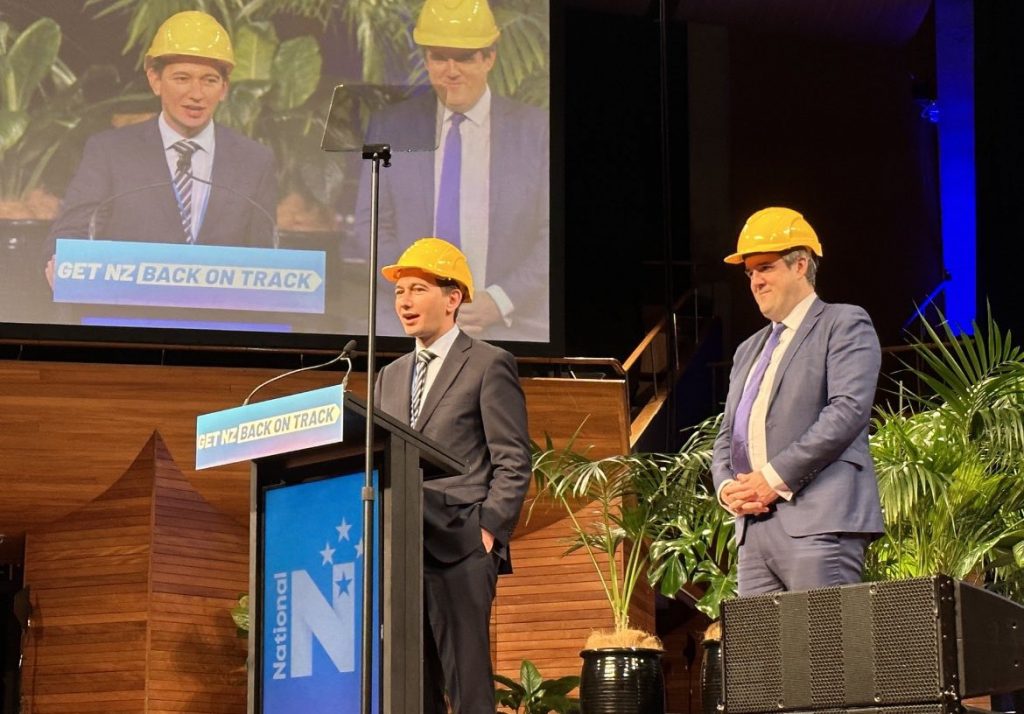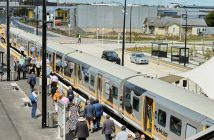As expected, the National Party’s transport policy is almost all about building lots of big roads, once again using the Roads of National Significance (RoNS) name, Greater Auckland’s Matt Lowrie writes

I think we’re up to the fourth version of the RoNS now, and just like at the last election, one of the headline features of the policy is to build a four-lane highway from Whangarei to Tauranga. It seems to be based on the idea of “four lanes good, two lanes bad”. While it certainly is much nicer and safer driving on a four-lane divided highway over a two lane road, that’s not the basis for a good transport policy.
National have included four public transport projects too – however, they’re all projects that are either funded and already underway, or appear to have some large caveats attached to them.
Other holes were quickly found with the policy, in the form of two 50km sections of the route missing (through the Brynderwyns and Kaimai Ranges), and out-of-date cost estimates for some included projects.
All up, National are claiming they’ll spend $17 billion over the next 10 years on the new RoNS 4.0, and that’s on top of the billions directed towards projects funded or already underway. A number of promised projects are ones that have been proposed and investigated in the past and been found wanting, but National just can’t seem to give them up.
As noted, the projected costs quickly came under fire from Labour who pointed out that on just four of the projects, National is using old figures – with the latest estimates being as much as $4.8 billion more.
- Tauriko West State Highway 29 – National has put the cost at $1.9 billion. Waka Kotahi’s latest estimates put the cost range at $2.5 – 3.25 billion ($600 million – $1.35 billion short).
- Warkworth to Wellsford Expressway – National says $2.2 billion. The latest Waka Kotahi estimate is $3.5 – $4 billion ($1.3 – $1.8 billion short).
- Cambridge to Piarere – National says $721 million. The latest Waka Kotahi estimate is $1.5 – $2 billion ($780 million – $1.28 billion short).
- Whangarei to Port Marsden – National says $1.3 billion. The latest Waka Kotahi estimate is $1.41 – $1.67 billion ($110 – $367 million short).
This is not surprising, given the large cost escalation of transport projects in recent years. It’s also likely that a number of the other projects on National’s list will end up being significantly higher too. For example, the East-West Link was estimated to cost $1.85b back in 2017 – at the time, it was estimated to be the most expensive highway project in the world, ever – and given what we’ve seen with other projects in recent years, it could easily be double that now.
To be fair to National, it’s not surprising they got some of these costs wrong, as I think this might have been the first time those new higher costs have made it into the public domain.
And while the cost escalation is not National’s fault, it will have a significant impact on the economic value of many of these projects. For example, based on that old cost of $2.2 billion, Warkworth to Wellsford was only predicted to have an economic return over a 40 year period of around 70c for every $1 it costs to build. With the price now up to $4 billion, and likely more by the time it starts, the economics of it will be even worse.
The key reason that is so low is that the road just doesn’t have the volume of traffic to justify a four-lane upgrade. Waka Kotahi says the trigger point to build it is 25k vehicles per day whereas the road only sees about 12k per day right now.
The issue of cost escalation is also highlighted by this graph I’ve put together of the cost of various roading projects per km. For those completed projects I’ve inflated them by CPI to get a fairer comparison. Note, not all projects are in here, as for some it can be hard to split out how costs are allocated. What you can see is the current projects under construction or proposed by National are in some cases orders of magnitude higher than what we’ve built in the past. Building roads at these kinds of costs is simply not sustainable – either financially or environmentally.
It’s disappointing and frustrating that we seem to have moved to a situation where it’s almost exclusively four lanes or nothing.
Though there are some non-RoNS projects National are committing to:
The Ashburton Bridge makes some sense, while the Queenstown and Otago-Southland bridge packages don’t have set outcomes and are just pots of money that they’ll decide what to do with later.
There are a couple of other comments worth noting too
- They’ll use Cyclone and Flood relief funding to upgrade the Hawkes Bay Expressway
- They’ll investigate expanding Penlink to four lanes
- They seem to think that funding an additional harbour crossing with private finance will make it cheaper.
Public Transport
National have included just four public transport projects in their policy – and as noted, two are already underway and the other two have large caveats.
Of these, the Eastern Busway is already underway, though as National correctly note, the final section from Burswood to Botany is not currently included in that. That section does need funding but it is disingenuous to claim they’ll be building the whole thing. It’s also worth noting that the total cost of the remaining sections of the busway is estimated at $1.3 billion, so the funding mentioned is likely just the government’s contribution – which means the rest of it is dependent on the council finding its share of the costs.
Similarly, the funding for the Airport to Botany project is also assumed to be around half of what’s required, with the council having to find the other $1.1 billion. To me, rapid transport projects should be considered at the same strategic level as state highways and should get full government funding just like state highways do.
The suggestion for the northwest is notable for a different reason. Firstly, it’s hilarious that National is blaming Labour for not building anything here when it was National who refused to incorporate a rapid transit line when the SH16 motorway was widened (and the causeway raised) less than a decade ago.
More worryingly, it seems like National is being wooed by the same arguments around private finance as Labour were with light rail, and promise to use it to build a line to the Northwest – though interestingly they don’t specify a mode. They specifically refer to the model used to build Vancouver’s Canada Line and Montreal’s just opened REM. The REM was built by CDPQ, the Canadian pension fund who worked with the NZ Superfund to derail light rail here.
Finally, National say they’ll fund the new regional trains for Wellington that Labour announced three months ago. The only difference is they say they’ll fund 22 new trains, whereas Labour’s funding was only to cover 18 new trains. The additional trains are welcome – but the majority of the claimed investment is already underway, so like the Eastern Busway, this is somewhat disingenuous from National.
They’ve dropped from their policy last election the promises to build a fourth main, to extend rail electrification to Pokeno and to add sections of double track north of Wellington.
Funding and Financing
In order to fund all of this, National want to reallocate funding within the National Land Transport fund, include an additional $6.3 billion in direct crown contributions and $9.5 billion in private funding.
The reallocation of money includes cutting $4.5 billion of funding from public transport and $3 billion from road safety, while once again capping road policing funding. They did this in their last time in office and it was a significant contributor to New Zealand’s worsening road safety outcomes.
A further $400 million will come from dropping funding currently allocated to building a rail spur to Marsden Point.
That direct Crown contribution is money that could otherwise be spent on things like hospitals or schools etc, but this has become an increasingly common tool for funding transport projects by both parties over the last decade.
More concerning is the private funding (or financing). In their policy, and throughout the week, National have claimed that there are trillions of dollars sitting in the likes of international pension funds just looking for a place to invest.
But it seems National have mixed up financing and funding.
While those pension funds are more than happy to invest in building infrastructure, we still have to pay for it. Both Transmission Gully and Puhoi to Warkworth were built with this model, and to service the debt on those roads, we’re locked into paying around $250 million annually for 25 years.
That’s money that comes straight out of the NLTF that then can’t be spent on other things, so could significantly hamper the ability of future governments to build and maintain our transport system.
Given National reference Montreal, it’s also worth a reminder that I’ve covered before how Montreal’s REM deal works. The TL;DR version is: CDPQ get to own 70% of the infrastructure, despite only paying for half of the project – and then enjoy an 8-9% annual return on their investment for a century.
These financing options are a sure-fire way for us to spend a lot more money over the long term to build infrastructure. A deal good for bankers, not so good for New Zealanders.
Future projects
National have indicated what their next priority projects will be, saying they’ll start or progress investigations on the following projects:
- Level crossing removal on Auckland’s rail network
- A fourth main rail line for Auckland
- Third bridge over the Waikato River in Cambridge
- Safety and resilience improvements to State Highway 1 between Taupo and Waiouru
- Palmerston North Ring Road
- Second access road into Wainuiomata
- Christchurch rapid transit
- Christchurch to Ashburton four-lane expressway
- Dublin Street bridge replacement in Whanganui
- A Stokes Valley-Haywards connector road on State Highway 2
In summary, there’s not a lot of surprises here, and there’s also not a lot to like. This is a transport policy that aims to set NZ back to the 1960s rather than set the country up for the future. It will result in more congestion, more emissions, more potholes and more people dying on our roads.














